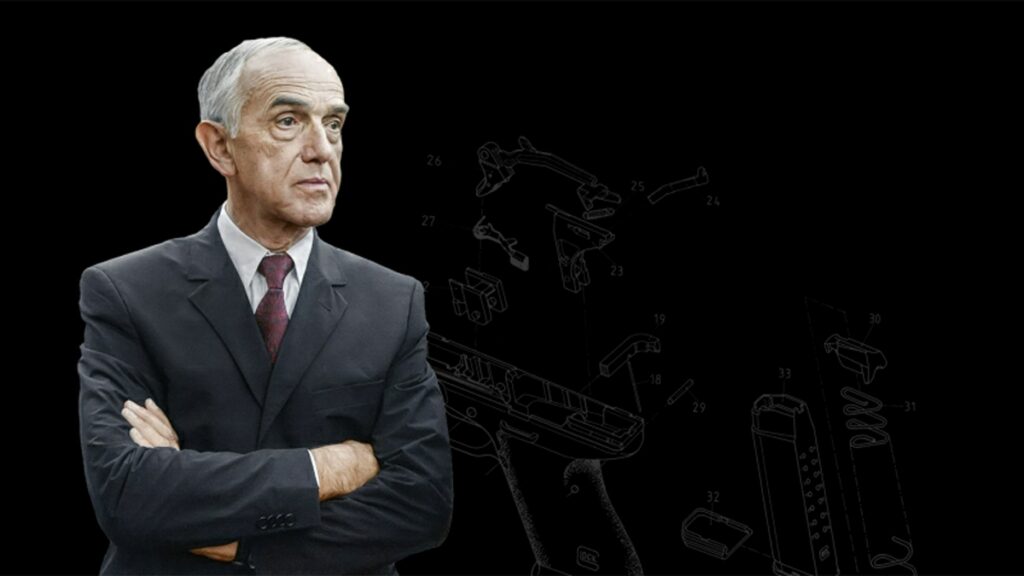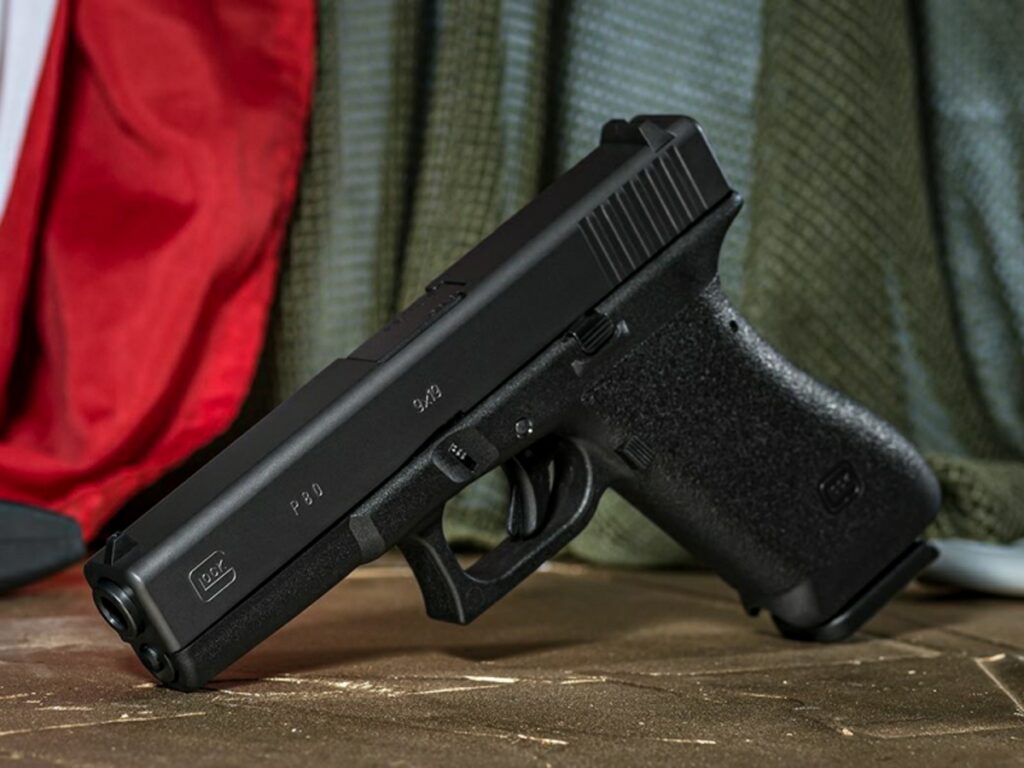Gaston Glock was probably the most influential handgun designer since John Moses Browning. Glock products revolutionized handgun designs, and even how those handguns were used. Barely four decades after the first Glock 17 pistol, Gaston Glock’s firearms dominate the law enforcement and civilian handgun markets, while maintaining a significant military presence as well.

Gaston Glock’s passing on December 27, 2023, at the age of 94 represents a loss to the firearms world equal to that of Browning, Eugene Stoner, and Mikhail Kalashnikov. The Glock corporation has been a model of consistency and quality, built on its founder’s vision of simplicity and reliability. The company’s future seems solid and Gaston Glock leaves a secure legacy. Let’s look briefly at how Glock built that legacy.
Gaston Glock’s Early Days
Gaston Glock was born in Vienna, Austria in 1929. He was conscripted briefly into the German Army in the closing days of World War II, as the Germans sought to bolster their ranks with men previously deemed too old or too young. Glock later studied mechanical engineering in Vienna, after which he worked in manufacturing.
Gaston and his first wife, Helga, opened a small business in their garage in 1963, making small consumer items like curtain rods and brass fittings. Glock Ges.m.b.H eventually developed a relationship with the Austrian military in the 1970s, making knife handles and sheaths, grenade casings, and machine gun belt links. This expansion led to experiments with molded polymers, setting the stage for Glock’s revolutionary handgun.
Gaston Glock: The Novice Gunmaker
By 1980, Glock employed 38 people and was looking for further business opportunities. He learned through his defense ministry contacts that the Austrian Army was looking to replace its World War II-era Walther P38 pistols.
Glock reportedly had not even held a firearm since his brief military service 35 years earlier. But he was determined to compete for the new P80 pistol contract. The Austrian Federal Ministry of Defense published 17 criteria for the new sidearm. Among other things, the ministry wanted a self-loading pistol chambered for 9mm Luger, with easily loaded magazines, that was drop safe from a height of two meters onto a steel plate.

But Glock’s lack of experience led him to look outside the Defense Ministry’s guidelines. He wanted to hear from the people who would use the P80. He consulted with firearms experts, specifically asking them what they would want in a modern service pistol. Glock’s experts told him they wanted a pistol that was easy to fire and easy to learn. It should be instantly deployable, with no concerns about whether the safety was on or not. It should also have a much higher capacity than the current models. Finally, it should be tough and reliable.
Glock acquired, examined, and tested the best available firearms, evaluating their performance and features within his established parameters. Glock’s lack of experience meant that he had no preconceptions about how such firearms should operate. He looked at it with an engineer’s eye, guided by his extensive research.
Glock’s findings, coupled with his knowledge of polymers and metallurgy, led to a sleek, durable, lightweight handgun whose reliability was based on its simplicity. Glock patented his new pistol the next year, dubbing it the Glock 17. The number 17 has no special meaning. It was merely the 17th patent for which Gaston Glock had applied. This was the gun he submitted to the Austrian Army trials in 1981.
The P80 Pistol
The Glock 17 won the P80 pistol trials, including a 15,000-round firing test, after which the trial guns were checked for wear. Each gun then fired a deliberately over-pressured test cartridge. But Glock was an unknown gunmaker, so the G17 was assigned a preliminary test. Before the trials even began, the Glock had to fire 10,000 rounds with no more than 20 stoppages. The pistol experienced only a single malfunction. So, the Glock 17 had to fire 25,000 rounds, while the others only fired 15,000.

Even with the extra requirement, the Glock 17 won the trials handily. The new pistol not only outperformed the others, but Gaston Glock’s price bid was 25 percent lower. His simple, quality design allowed him to streamline costs in a way competing manufacturers could not at the time. The Defense Ministry adopted the Glock 17 as the P80 in 1983.
The ministry also awarded Glock a contract for 25,000 guns plus spare parts. Glock Ges.m.b.H had to expand its Deutsch-Wagram, Austria production facility quickly. 38 employees weren’t nearly enough. The Glock 17 passed the NATO durability test in 1984, prompting the Norwegian Army to adopt the gun as well. The Glock was gaining international attention, and its creator turned his eyes toward the United States.
Smart Marketing
Gaston Glock knew he wanted to enter the lucrative American civilian market. He also knew that American gun owners often took their cues from law enforcement agencies. So, with that in mind, Glock set about winning police contracts. The first move was to invite respected gun writer Peter Kokalis to Austria. Kokalis ran the Glock 17 and loved it. His enthusiastic review, titled “Plastic Perfection,” ran in Soldier of Fortune Magazine’s October 1984 issue. “Glock Perfection” was born. Kokalis boldly wrote that the Glock 17 was “the finest military pistol in the world today.” The article spread through American professionals, prepping the market for Glock’s 1986 grand opening in Smyrna, Georgia.

Glock’s American expansion came at just the right time. The drug trade exploded in the mid-1980s, leaving revolver-equipped cops outgunned by gangs wielding modern weapons. Glock offered discounted prices to agencies looking to upgrade, and many accepted. Today, some 65 percent of American law enforcement agencies use Glocks.
Law enforcement adoption paid off on the civilian side since people trusted police firearms. Those people were also willing to pay full retail price, which was still competitive. Glock had the right gun, at the right time, at the right price. It wasn’t long before American police forces and consumers wanted a more compact pistol, which Glock delivered in 1989 as the Glock 19. The gun-making industry scrambled to catch up.
Gaston Glock, the Man
Glock, himself, was mostly reclusive as his company grew exponentially. He was undoubtedly deeply involved, but not publicly. Gun control organizations quickly propagandized his firearms, often making wild accusations regarding the company, its products, and its founder. Glock rarely responded, preferring to attend to business rather than politics.
One very public incident, however, demonstrated Glock’s fortitude. Glock seemingly caught his financial advisor, Charles Ewert, embezzling funds. He went to Luxembourg to confront Ewert, but Ewert acted first. He hired a former professional wrestler named Jacques Pêcheur to ambush Glock in a parking garage and kill him. The 70-year-old Glock fended off the rubber mallet-armed assassin, and even knocked out some of his teeth. Glock was injured but recovered. His only comment on the attack was that he was glad it happened, so he knew not to trust Ewert anymore. Ewert and Pêcheur were both convicted and imprisoned.
Gaston Glock’s Legacy
Glock’s legacy is vast but simple. He dedicated himself to producing a quality, reliable, user-friendly firearm whose strength was its rugged simplicity. Despite marketing claims, Glock handguns do not represent “perfection.’ Nothing is perfect. But they are arguably the most consistently excellent semi-automatic handguns ever conceived.

Factory Glocks aren’t fancy. They were never meant to be fancy. Gaston Glock devised a formula that works, and he stuck to it. Modern Gen 5 Glock 17s don’t look much different from the 1983 model. That’s because that 1983 Glock ran, just as it was designed to do. Why change something that works? Sure, you can tweak things, and Glock has done that. But the basic pistol remains very close to the original.
Gaston Glock’s vision revolutionized the firearms industry. Simplicity and reliability became the watchword for duty and concealed carry pistols. You can still buy the bells-and-whistles firearms, but as the saying goes, those are the guns you show your friends. The Glock is the gun you show your enemies.









